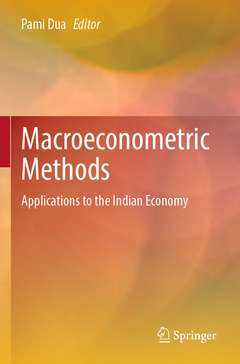Description
Macroeconometric Methods, 2023
Applications to the Indian Economy
Coordinator: Dua Pami
Language: English
Subjects for Macroeconometric Methods:
Keywords
Macroeconometrics; Indian Economy; Time Series; Macroeconomics; Econometrics
Macroeconometric Methods
Publication date: 04-2024
373 p. · 15.5x23.5 cm · Paperback
Publication date: 04-2024
373 p. · 15.5x23.5 cm · Paperback
Macroeconometric Methods
Publication date: 04-2023
373 p. · 15.5x23.5 cm · Hardback
Publication date: 04-2023
373 p. · 15.5x23.5 cm · Hardback
Description
/li>Contents
/li>Biography
/li>Comment
/li>
This book provides empirical applications of macroeconometric methods through discussions on key issues in the Indian economy. It deals with issues of topical relevance in the arena of macroeconomics. The aim is to apply time series and financial econometric methods to macroeconomic issues of an emerging economy such as India. The data sources are given in each chapter, and students and researchers may replicate the analyses.
The book is divided into three parts?Part I: Macroeconomic Modelling and Policy; Part II: Forecasting the Indian Economy and Part III: Business Cycles and Global Crises. It provides a holistic understanding of the techniques with each chapter delving into a relevant issue analysed using appropriate methods?Chapter 1: Introduction; Chapter 2: Macroeconomic Modelling and Bayesian Methods; Chapter 3: Monetary Policy Framework in India; Chapter 4: Determinants of Yields on Government Securities in India; Chapter 5: Monetar y Transmission in the Indian Economy; Chapter 6: India?s Bilateral Export Growth and Exchange Rate Volatility: A Panel GMM Approach; Chapter 7: Aggregate and Sectoral Productivity Growth in the Indian Economy: Analysis and Determinants; Chapter 8: Forecasting the INR/USD Exchange Rate: A BVAR Framework; Chapter 9: Forecasting India?s Inflation in a Data-Rich Environment: A FAVAR Study; Chapter 10: A Structural Macroeconometric Model for India; Chapter 11: International Synchronization of Growth Rate Cycles: An Analysis in Frequency Domain; Chapter 12: Inter-Linkages Between Asian and U.S. Stock Market Returns: A Multivariate GARCH Analysis; Chapter 13: The Increasing Synchronization of International Recessions.
Since the selection of issues is from macroeconomic aspects of the Indian economy, the book has wide applications and is useful for students and researchers of fields such as applied econometrics, time series econometrics, financial econometrics, forecasting methods andmacroeconomics.
Chapter 1: Introduction.- Part I: Macroeconomic Modelling and Policy.- Chapter 2: Macroeconomic Modelling and Bayesian Methods.- Chapter 3: Monetary Policy Framework in India.- Chapter 4: Determinants of Yields on Government Securities in India.- Chapter 5: Monetar y Transmission in the Indian Economy.- Chapter 6: India’s Bilateral Export Growth and Exchange Rate Volatility: A Panel GMM Approach.- Chapter 7: Aggregate and Sectoral Productivity Growth in the Indian Economy: Analysis and Determinants.- Part II: Forecasting the Indian Economy.- Chapter 8: Forecasting the INR/USD Exchange Rate: A BVAR Framework.- Chapter 9: Forecasting India’s Inflation in a Data-Rich Environment: A FAVAR Study.- Part III: Business Cycles and Global Crises.- Chapter 10: A Structural Macroeconometric Model for India.- Chapter 11: International Synchronization of Growth Rate Cycles: An Analysis in Frequency Domain.- Chapter 12: Inter-Linkages Between Asian and U.S. Stock Market Returns: A Multivariate GARCH Analysis.- Chapter 13: The Increasing Synchronization of International Recessions.
Dr. Pami Dua is Director of the Delhi School of Economics and Senior Professor of Economics. She has served the University of Delhi in various capacities including Dean of Academic Activities and Projects; Chairperson, Research Council; Dean Research of Humanities and Social Sciences and Coordinator, Internal Quality Assurance Cell of the University of Delhi.
She was a Member of the first Monetary Policy Committee of the Reserve Bank of India from 2016 to 2020. She is currently Co-Chair of the Task Force on Macroeconomics, Trade and Livelihoods under Think20 (T20) India / G20 India. She is also an Honorary Distinguished Fellow (non-resident) of the Indira Gandhi Institute of Development Research (IGIDR), Mumbai, and Member of the Governing Council of the Centre for Advanced Financial Research and Learning (CAFRAL). She is a member of the Governing Body and Academic Council of the Dayalbagh Educational Institute. She is also a member of the Governing Council of the Madras Institute of Development Studies (MIDS) and is affiliated with the Economic Cycle Research Institute (ECRI) in New York. She earlier served as President of the Indian Econometric Society and has been Editor of the Indian Economic Review, a reputed journal of the Delhi School of Economics, for almost two decades.
She has published numerous research papers in renowned international journals as well as books and chapters in her fields of study, viz. time series econometrics, forecasting, macroeconometrics, monetary policy and business cycle analysis. She has over three and a half decades of experience in teaching of macroeconomics, econometrics and forecasting. She earlier taught at the University of Connecticut, USA, and Wayne State University, Michigan, USA, and has also been affiliated with Yale University as well as Columbia University.
She completed her B.A. (Hons.) in Economics from Lady Shri Ram C
Discusses contemporary Indian issues for students of advanced econometrics Explains a complex technique in each chapter including the application Provides details of data and methods for students to replicate and extend the analyses
© 2024 LAVOISIER S.A.S.
These books may interest you

India Development Report 2017NA 47.09 €



